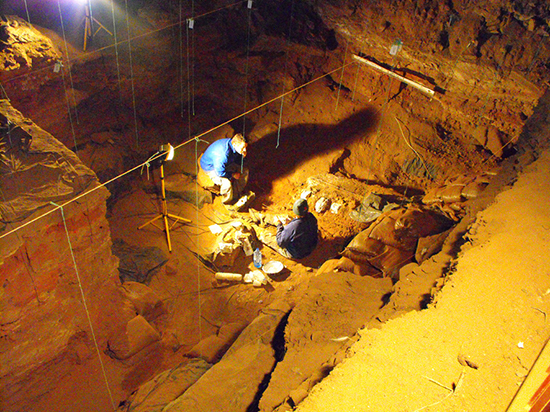Latest News Archive
Please select Category, Year, and then Month to display items
05 June 2018
Photo Supplied
 Archaeological excavations in the Wonderwerk Cave, north of Kuruman in the Northern Cape.
Archaeological excavations in the Wonderwerk Cave, north of Kuruman in the Northern Cape.
Research fellow Dr Lloyd Rossouw from the Department of Plant Sciences at the University of the Free State (UFS) recently published an article in the Nature Ecology and Evolution journal with Dr Michaela Ecker from the University of Toronto as lead author, and Dr James Brink, research fellow at the UFS Centre for Environmental Management. The findings described in “The palaeoecological context of the Oldowan-Acheulean in southern Africa” provides the first extensive paleoenvironmental sequence for the interior of southern Africa by applying a combination of methods for environmental reconstruction at Wonderwerk Cave, which have yielded multiple evidence of early human occupation dating back almost two million years ago.
Where water once was
The Wonderwerk Cave is found north of the Kuruman hills (situated in Northern Cape) a 140m long tube with a low ceiling. The surroundings are harsh. Semi-arid conditions allow for the survival of only hardy bushes, trees, and grasses. But during the Early Pleistocene, stepping out of the Wonderwerk Cave you would have been greeted by a completely different site, the researchers found. Using carbon and oxygen stable isotope analysis on the teeth of herbivores (Dr Ecker), fossil faunal abundance (Dr Brink), as well as the analysis of microscopic plant silica remains (phytoliths) excavated from fossil soils inside the cave (Dr Rossouw), the results show that ancient environments in the central interior of southern Africa were significantly wetter and housed a plant community unlike any other in the modern African savanna.
What difference does it make?
While East African research shows increasing aridity and the spread of summer-rainfall grasslands more than a million years ago, the results from this study indicate an interesting twist. During the same period, shifts in rainfall seasonality allowed for alternating summer and winter-rainfall grass occurrences coupled with prolonged wetlands, that remained major components of Early Pleistocene (more or less the period between one and two million years ago) environments in the central interior of southern Africa. That means our human ancestors were also living and evolving in environments other than the generally accepted open, arid grassland model.
Meet the Shimlas’ Miss Varsity Cup 2017
2017-04-12

Jadene Jacobs didn’t expect to be
crowned as Shimlas’ Miss Varsity Cup.
Photo: Robin Butler
Her mom motivated her to take part in modelling competitions when she was still in primary school, and Jadene Jacobs has loved it ever since.
The 19-year-old first-year BSc Chemistry and Physics student is excited to represent us at the nationals of the Miss Varsity Cup 2017 on 17 April. Although she never thought she would win the competition, Jadene was recently crowned Shimlas’ Miss Varsity Cup 2017.
Her role model in the industry is the former Miss World, Rolene Strauss, who previously also was a Shimla Miss Varsity Cup. Jadene likes Rolene’s compassion, beauty, and flawlessness.
Jadene, who is from Johannesburg, cannot wait to meet the Miss Varsity Cups from the other universities. “I am mentally prepared for the nationals, and I am ready to give it my all,” she said.
She found out about the competition at Wag-’n-Bietjie, her residence on the Bloemfontein Campus, and didn’t think twice about entering. Jadene is passionate about sport and lives an active lifestyle. She also plays netball in her spare time.
Vote for Jadene (until 17 April 2017).